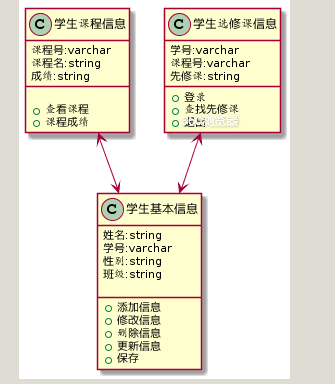UML第二次作业
一、plant UML语法学习小结
1.类之间的关系

使用.. 来代替 -- 可以得到点 线.
在这些规则下,也可以绘制下列图形
@startuml
Class01 <|-- Class02 Class03 *-- Class04 Class05 o-- Class06 Class07 .. Class08 Class09 -- Class10 @enduml
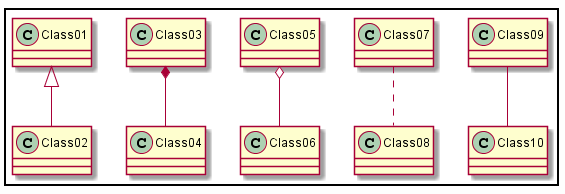
@startuml
Class11 <|.. Class12
Class13 --> Class14
Class15 ..> Class16
Class17 ..|> Class18
Class19 <--* Class20
@enduml
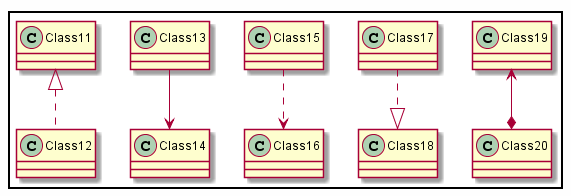
Class21 #-- Class22
Class23 x-- Class24
Class25 }-- Class26
Class27 +-- Class28
Class29 ^-- Class30
@enduml

2、关系上的标识
在关系之间使用标签来说明时, 使用 :后接 标签文字。
对元素的说明,你可以在每一边使用 "" 来说明.
@startuml Class01 "1" *-- "many" Class02 : contains Class03 o-- Class04 : aggregation Class05 --> "1" Class06 @enduml
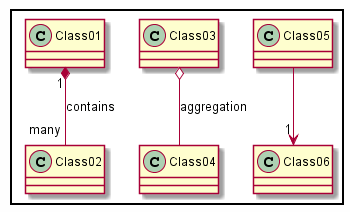
在标签的开始或结束位置添加< 或 >以表明是哪个对象作用到哪个对象上。
@startuml class Car Driver - Car : drives > Car *- Wheel : have 4 > Car -- Person : < owns @enduml
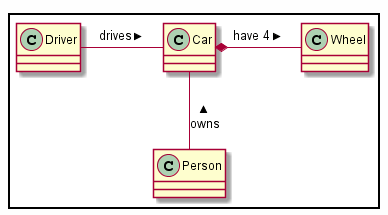
3、添加方法
为了声明域或者方法,你可以使用 后接域名或方法名。
系统检查是否有括号来判断是方法还是域。
@startuml Object <|-- ArrayList Object : equals() ArrayList : Object[] elementData ArrayList : size() @enduml

也可以使用{} 把域或者方法括起来
注意,这种语法对于类型/名字的顺序是非常灵活的。
@startuml
class Dummy {
String data
void methods()
}
class Flight {
flightNumber : Integer
departureTime : Date
}
@enduml

You can use {field} and {method} modifiers to override default behaviour of the parser about fields and methods.
@startuml
class Dummy {
{field} A field (despite parentheses)
{method} Some method
}
@enduml

4.定义可访问性
一旦你定义了域或者方法,你可以定义 相应条目的可访问性质。
| Character | Icon for field | Icon for method | Visibility |
- |
 |
 |
private |
# |
 |
 |
protected |
~ |
 |
 |
package private |
+ |
 |
 |
public |
@startuml
class Dummy {
-field1
#field2
~method1()
+method2()
}
@enduml

你可以采用以下命令停用这些特性 skinparam classAttributeIconSize 0 :
@startuml
skinparam classAttributeIconSize 0
class Dummy {
-field1
#field2
~method1()
+method2()
}
@enduml

5.抽象与静态
通过修饰符{static}或者{abstract},可以定义静态或者抽象的方法或者属性。
这些修饰符可以写在行的开始或者结束。也可以使用{classifier}这个修饰符来代替{static}.
@startuml
class Dummy {
{static} String id
{abstract} void methods()
}
@enduml

6.高级类体
PlantUML默认自动将方法和属性重新分组,你可以自己定义分隔符来重排方法和属性,下面的分隔符都是可用的:--..==__.
还可以在分隔符中添加标题:
@startuml
class Foo1 {
You can use
several lines
..
as you want
and group
==
things together.
__
You can have as many groups
as you want
--
End of class
}
class User {
.. Simple Getter ..
+ getName()
+ getAddress()
.. Some setter ..
+ setName()
__ private data __
int age
-- encrypted --
String password
}
@enduml

7.备注和模板
模板通过类关键字("<<"和">>")来定义
你可以使用note left of , note right of , note top of , note bottom of这些关键字来添加备注。
你还可以在类的声明末尾使用note left, note right,note top, note bottom来添加备注。
此外,单独用note这个关键字也是可以的,使用 .. 符号可以作出一条连接它与其它对象的虚线。
@startuml class Object << general >> Object <|--- ArrayList note top of Object : In java, every class\nextends this one. note "This is a floating note" as N1 note "This note is connected\nto several objects." as N2 Object .. N2 N2 .. ArrayList class Foo note left: On last defined class @enduml

8.更多注释
可以在注释中使用部分html标签:
<b><u><i><s>,<del>,<strike><font color="#AAAAAA">or<font color="colorName"><color:#AAAAAA>or<color:colorName><size:nn>to change font size<img src="file">or<img:file>: the file must be accessible by the filesystem
你也可以在注释中展示多行。
你也可以在定义的class之后直接使用 note left, note right, note top, note bottom 来定义注释。
@startuml class Foo note left: On last defined class note top of Object In java, <size:18>every</size> <u>class</u> <b>extends</b> <i>this</i> one. end note note as N1 This note is <u>also</u> <b><color:royalBlue>on several</color> <s>words</s> lines And this is hosted by <img:sourceforge.jpg> end note @enduml

9.链接的注释
在定义链接之后,你可以用 note on link 给链接添加注释
如果想要改变注释相对于标签的位置,你也可以用 note left on link, note right on link, note bottom on link。(对应位置分别在label的左边,右边,下边)
@startuml class Dummy Dummy --> Foo : A link note on link #red: note that is red Dummy --> Foo2 : Another link note right on link #blue this is my note on right link and in blue end note @enduml

10.抽象类和接口
用关键字abstract或abstract class来定义抽象类。抽象类用斜体显示。 也可以使用interface, annotation 和 enum关键字。
@startuml
abstract class AbstractList
abstract AbstractCollection
interface List
interface Collection
List <|-- AbstractList
Collection <|-- AbstractCollection
Collection <|- List
AbstractCollection <|- AbstractList
AbstractList <|-- ArrayList
class ArrayList {
Object[] elementData
size()
}
enum TimeUnit {
DAYS
HOURS
MINUTES
}
annotation SuppressWarnings
@enduml

11.使用非字母字符
如果你想在类(或者枚举)的显示中使用非字母符号,你可以:
- 在类的定义中使用
as关键字 - 在类名旁边加上
""
@startuml class "This is my class" as class1 class class2 as "It works this way too" class2 *-- "foo/dummy" : use @enduml

12.隐藏属性、函数等
通过使用命令“hide/show”,你可以用参数表示类的显示方式。
基础命令是: hide empty members. 这个命令会隐藏空白的方法和属性。
除 empty members 外,你可以用:
empty fields或者empty attributes空属性,empty methods空函数,fields或attributes隐藏字段或属性,即使是被定义了methods隐藏方法,即使是被定义了members隐藏字段 和 方法,即使是被定义了circle类名前带圈的,stereotype原型。
同样可以使用 hide 或 show 关键词,对以下内容进行设置:
class所有类,interface所有接口,enum所有枚举,<<foo1>>实现 foo1 的类,- 一个既定的类名。
你可以使用 show/hide 命令来定义相关规则和例外。
@startuml
class Dummy1 {
+myMethods()
}
class Dummy2 {
+hiddenMethod()
}
class Dummy3 <<Serializable>> {
String name
}
hide members
hide <<Serializable>> circle
show Dummy1 methods
show <<Serializable>> fields
@enduml

13.隐藏类
你也可以使用 show/hide 命令来隐藏类
如果你定义了一个大的!included 文件,且想在文件包含之后隐藏部分类,该功能会很有帮助。
@startuml class Foo1 class Foo2 Foo2 *-- Foo1 hide Foo2 @enduml

14.泛型(generics)
你可以用 < 和 > 来定义类的泛型。
@startuml
class Foo<? extends Element> {
int size()
}
Foo *- Element
@enduml

It is possible to disable this drawing using skinparam genericDisplay old command.
15.包
你可以通过关键词 package 声明包,同时可选的来声明对应的背景色(通过使用html色彩代码或名称)。
注意:包可以被定义为嵌套。
@startuml
package "Classic Collections" #DDDDDD {
Object <|-- ArrayList
}
package net.sourceforge.plantuml {
Object <|-- Demo1
Demo1 *- Demo2
}
@enduml

16.包样式
包可以定义不同的样式。
你可以通过以下的命令来设置默认样式 : skinparam packageStyle,或者对包使用对应的模板:
@startuml
scale 750 width
package foo1 <<Node>> {
class Class1
}
package foo2 <<Rectangle>> {
class Class2
}
package foo3 <<Folder>> {
class Class3
}
package foo4 <<Frame>> {
class Class4
}
package foo5 <<Cloud>> {
class Class5
}
package foo6 <<Database>> {
class Class6
}
@enduml

你也可以参考下面的示例来定义包之间的连线:
@startuml
skinparam packageStyle rectangle
package foo1.foo2 {
}
package foo1.foo2.foo3 {
class Object
}
foo1.foo2 +-- foo1.foo2.foo3
@enduml

17.命名空间(Namespaces)
In packages, the name of a class is the unique identifier of this class. It means that you cannot have two classes with the very same name in different packages.
In that case, you should use namespacesinstead of packages.
You can refer to classes from other namespaces by fully qualify them. Classes from the default namespace are qualified with a starting dot.
Note that you don't have to explicitly create namespace : a fully qualified class is automatically put in the right namespace.
@startuml
class BaseClass
namespace net.dummy #DDDDDD {
.BaseClass <|-- Person
Meeting o-- Person
.BaseClass <|- Meeting
}
namespace net.foo {
net.dummy.Person <|- Person
.BaseClass <|-- Person
net.dummy.Meeting o-- Person
}
BaseClass <|-- net.unused.Person
@enduml

18.自动创建命名空间
使用命令 set namespaceSeparator ??? 你可以自定义命名空间分隔符(为 “.” 以外的字符).
@startuml
set namespaceSeparator ::
class X1::X2::foo {
some info
}
@enduml

禁止自动创建包则可以使用 set namespaceSeparator none.
@startuml
set namespaceSeparator none
class X1.X2.foo {
some info
}
@enduml

19.棒棒糖 接口
需要定义棒棒糖样式的接口时可以遵循以下语法:
bar ()- foobar ()-- foofoo -() bar
@startuml class foo bar ()- foo @enduml

20.改变箭头方向
类之间默认采用两个破折号 -- 显示出垂直 方向的线. 要得到水平方向的可以像这样使用单破折号 (或者点):
@startuml Room o- Student Room *-- Chair @enduml

你也可以通过改变倒置链接来改变方向
@startuml Student -o Room Chair --* Room @enduml

也可通过在箭头内部使用关键字, 例如left, right, up 或者 down,来改变方向
@startuml foo -left-> dummyLeft foo -right-> dummyRight foo -up-> dummyUp foo -down-> dummyDown @enduml

You can shorten the arrow by using only the first character of the direction (for example, -d- instead of -down-) or the two first characters (-do-).
Please note that you should not abuse this functionality : Graphviz gives usually good results without tweaking.
21.“关系”类
你可以在定义了两个类之间的关系后定义一个 关系类 association class 例如:
@startuml
class Student {
Name
}
Student "0..*" - "1..*" Course
(Student, Course) .. Enrollment
class Enrollment {
drop()
cancel()
}
@enduml

也可以用另一种方式:
@startuml
class Student {
Name
}
Student "0..*" -- "1..*" Course
(Student, Course) . Enrollment
class Enrollment {
drop()
cancel()
}
@enduml

22.皮肤参数
用skinparam改变字体和颜色。
可以在如下场景中使用:
- 在图示的定义中,
- 在引入的文件中,
- 在命令行或者ANT任务提供的配置文件中。
@startuml
skinparam class {
BackgroundColor PaleGreen
ArrowColor SeaGreen
BorderColor SpringGreen
}
skinparam stereotypeCBackgroundColor YellowGreen
Class01 "1" *-- "many" Class02 : contains
Class03 o-- Class04 : aggregation
@enduml

Skinned Stereotypes
You can define specific color and fonts for stereotyped classes.
@startuml
skinparam class {
BackgroundColor PaleGreen
ArrowColor SeaGreen
BorderColor SpringGreen
BackgroundColor<<Foo>> Wheat
BorderColor<<Foo>> Tomato
}
skinparam stereotypeCBackgroundColor YellowGreen
skinparam stereotypeCBackgroundColor<< Foo >> DimGray
Class01 <<Foo>>
Class03 <<Foo>>
Class01 "1" *-- "many" Class02 : contains
Class03 o-- Class04 : aggregation
@enduml

Color gradient
It's possible to declare individual color for classes or note using the # notation.
You can use either standard color nameor RGB code.
You can also use color gradient in background, with the following syntax: two colors names separated either by:
|,/,\,- or
-
depending the direction of the gradient.
For example, you could have:
@startuml
skinparam backgroundcolor AntiqueWhite/Gold
skinparam classBackgroundColor Wheat|CornflowerBlue
class Foo #red-green
note left of Foo #blue\9932CC
this is my
note on this class
end note
package example #GreenYellow/LightGoldenRodYellow {
class Dummy
}
@enduml

Help on layout
Sometimes, the default layout is not perfect...
You can use together keyword to group some classes together : the layout engine will try to group them (as if they were in the same package).
You can also use hidden links to force the layout.
@startuml
class Bar1
class Bar2
together {
class Together1
class Together2
class Together3
}
Together1 - Together2
Together2 - Together3
Together2 -[hidden]--> Bar1
Bar1 -[hidden]> Bar2
@enduml

23.拆分大文件
有些情况下,会有一些很大的图片文件。
可以用 page (hpages)x(vpages) 这个命令把生成的图片文件拆分成若干个文件。
hpages 用来表示水平方向页面数, and vpages 用来表示垂直方面页面数。
你也可以使用特定的皮肤设定来给分页添加边框(见例子)
@startuml
' Split into 4 pages
page 2x2
skinparam pageMargin 10
skinparam pageExternalColor gray
skinparam pageBorderColor black
class BaseClass
namespace net.dummy #DDDDDD {
.BaseClass <|-- Person
Meeting o-- Person
.BaseClass <|- Meeting
}
namespace net.foo {
net.dummy.Person <|- Person
.BaseClass <|-- Person
net.dummy.Meeting o-- Person
}
BaseClass <|-- net.unused.Person
@enduml

二、班级学生管理系统中的 —— “学生” 类的属性、方法
属性:
学生基本信息:学号,姓名,性别 , 班级 ,
学生课程信息:课程号 , 课程名 , 成绩 ,
学生选修课信息:学号,课程号,先修课。
三、类图脚本程序
@startuml
class 学生基本信息 {
姓名:string
学号:varchar
性别:string
班级:string
__
+添加信息
+修改信息
+删除信息
+更新信息
+保存
}
class 学生课程信息{
课程号:varchar
课程名:string
成绩:string
__
+查看课程
+课程成绩
}
class 学生选修课信息 {
学号:varchar
课程号:varchar
先修课:string
__
+登录
+查找先修课
+退出
}
学生课程信息 <--> 学生基本信息
学生选修课信息 <--> 学生基本信息
@enduml
四、类图示例
